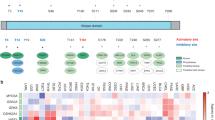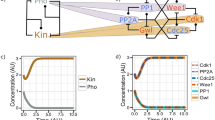Abstract
Cell-cycle transitions in higher eukaryotes are regulated by different cyclin-dependent kinases (CDKs) and their activating cyclin subunits. Based on pioneering findings that a dominant-negative mutation of CDK1 blocks the cell cycle at G2–M phase, whereas dominant-negative CDK2 inhibits the transition into S phase, a model of cell-cycle control has emerged in which each transition is regulated by a specific subset of CDKs and cyclins. Recent work with gene-targeted mice has led to a revision of this model. We discuss cell-cycle control in light of overlapping and essential functions of the different CDKs and cyclins.
This is a preview of subscription content, access via your institution
Access options
Subscribe to this journal
Receive 12 print issues and online access
$189.00 per year
only $15.75 per issue
Buy this article
- Purchase on Springer Link
- Instant access to full article PDF
Prices may be subject to local taxes which are calculated during checkout

Similar content being viewed by others
References
Morgan, D. O. The Cell Cycle; Principles of Control (New Science Press, London, 2007).
Harper, J. W. & Elledge, S. J. The role of Cdk7 in CAK function, a retro-retrospective. Genes Dev. 12, 285–289 (1998).
Peters, J. M. The anaphase promoting complex/cyclosome: a machine designed to destroy. Nature Rev. Mol. Cell Biol. 7, 644–656 (2006).
Kellogg, D. R. Wee1-dependent mechanisms required for coordination of cell growth and cell division. J. Cell Sci. 116, 4883–4890 (2003).
Kobayashi, H., Stewart, E., Poon, R. Y. & Hunt, T. Cyclin A and cyclin B dissociate from p34cdc2 with half-times of 4 and 15 h, respectively, regardless of the phase of the cell cycle. J. Biol. Chem. 269, 29153–29160 (1994).
Nurse, P. A long twentieth century of the cell cycle and beyond. Cell 100, 71–78 (2000).
van den Heuvel, S. & Harlow, E. Distinct roles for cyclin-dependent kinases in cell cycle control. Science 262, 2050–2054 (1993).
Pagano, M. et al. Regulation of the cell cycle by the cdk2 protein kinase in cultured human fibroblasts. J. Cell Biol. 121, 101–111 (1993).
Sherr, C. J. Mammalian G1 cyclins. Cell 73, 1059–1065 (1993).
Ortega, S. et al. Cyclin-dependent kinase 2 is essential for meiosis but not for mitotic cell division in mice. Nature Genet. 35, 25–31 (2003).
Berthet, C., Aleem, E., Coppola, V., Tessarollo, L. & Kaldis, P. Cdk2 knockout mice are viable. Curr. Biol. 13, 1775–1785 (2003).
Aleem, E., Kiyokawa, H. & Kaldis, P. Cdc2-cyclin E complexes regulate the G1/S phase transition. Nature Cell Biol. 7, 831–836 (2005).
Hochegger, H. et al. An essential role for Cdk1 in S phase control is revealed via chemical genetics in vertebrate cells. J. Cell Biol. 178, 257–268 (2007).
Krasinska, L. et al. Cdk1 and Cdk2 activity levels determine the efficiency of replication origin firing in Xenopus. EMBO J. 27, 758–769 (2008).
Santamaria, D. et al. Cdk1 is sufficient to drive the mammalian cell cycle. Nature 448, 811–815 (2007).
Malumbres, M. & Barbacid, M. Mammalian cyclin-dependent kinases. Trends Biochem. Sci. 30, 630–641 (2005).
Barbacid, M. et al. Cell cycle and cancer: genetic analysis of the role of cyclin-dependent kinases. Cold Spring Harb. Symp. Quant. Biol. 70, 233–240 (2005).
Berthet, C. & Kaldis, P. Cell-specific responses to loss of cyclin-dependent kinases. Oncogene 26, 4469–4477 (2007).
Orlando, D. A. et al. Global control of cell-cycle transcription by coupled CDK and network oscillators. Nature 453, 944–947 (2008).
Petri, E. T., Errico, A., Escobedo, L., Hunt, T. & Basavappa, R. The crystal structure of human cyclin B. Cell Cycle 6, 1342–1349 (2007).
Bloom, J. & Cross, F. R. Multiple levels of cyclin specificity in cell-cycle control. Nature Rev. Mol. Cell Biol. 8, 149–160 (2007).
Loog, M. & Morgan, D. O. Cyclin specificity in the phosphorylation of cyclin-dependent kinase substrates. Nature 434, 104–108 (2005).
Fisher, D. L. & Nurse, P. A single fission yeast mitotic cyclin B p34cdc2 kinase promotes both S-phase and mitosis in the absence of G1 cyclins. EMBO J. 15, 850–860 (1996).
Stern, B. & Nurse, P. A quantitative model for the cdc2 control of S phase and mitosis in fission yeast. Trends Genet. 12, 345–350 (1996).
Arias, E. E. & Walter, J. C. Strength in numbers: preventing rereplication via multiple mechanisms in eukaryotic cells. Genes Dev. 21, 497–518 (2007).
Zegerman, P. & Diffley, J. F. Phosphorylation of Sld2 and Sld3 by cyclin-dependent kinases promotes DNA replication in budding yeast. Nature 445, 281–285 (2007).
Tanaka, S. et al. CDK-dependent phosphorylation of Sld2 and Sld3 initiates DNA replication in budding yeast. Nature 445, 328–332 (2007).
Blethrow, J. D., Glavy, J. S., Morgan, D. O. & Shokat, K. M. Covalent capture of kinase-specific phosphopeptides reveals Cdk1–cyclin B substrates. Proc. Natl Acad. Sci. USA 105, 1442–1447 (2008).
Pines, J. & Hunter, T. The differential localization of human cyclins A and B is due to a cytoplasmic retention signal in cyclin B. EMBO J. 13, 3772–3781 (1994).
Kozar, K. et al. Mouse development and cell proliferation in the absence of D-cyclins. Cell 118, 477–491 (2004).
Geng, Y. et al. Cyclin E ablation in the mouse. Cell 114, 431–443 (2003).
Murphy, M. et al. Delayed early embryonic lethality following disruption of the murine cyclin A2 gene. Nature Genet. 15, 83–86 (1997).
Brandeis, M. et al. Cyclin B2-null mice develop normally and are fertile whereas cyclin B1-null mice die in utero. Proc. Natl Acad. Sci. USA 95, 4344–4349 (1998).
Liu, D. et al. Cyclin A1 is required for meiosis in the male mouse. Nature Genet. 20, 377–380 (1998).
Jacobs, H. W., Knoblich, J. A. & Lehner, C. F. Drosophila cyclin B3 is required for female fertility and is dispensable for mitosis like cyclin B. Genes Dev. 12, 3741–3751 (1998).
Jin, P., Hardy, S. & Morgan, D. O. Nuclear localization of cyclin B1 controls mitotic entry after DNA damage. J. Cell Biol. 141, 875–885 (1998).
Hagting, A., Karlsson, C., Clute, P., Jackman, M. & Pines, J. MPF localization is controlled by nuclear export. EMBO J. 17, 4127–4138 (1998).
Garci-Higuera, I. et al. Genomic stability and tumour suppression by the APC/C cofactor Cdh1. Nature Cell Biol. 10, 802–811 (2008).
Nurse, P. Regulation of the eukaryotic cell cycle. Eur. J. Cancer 33, 1002–1004 (1997).
Zhou, B. B. & Elledge, S. J. The DNA damage response: putting checkpoints in perspective. Nature 408, 433–439 (2000).
Pomerening, J. R., Ubersax, J. A. & Ferrell, J. E. Jr. Rapid cycling and precocious termination of G1 phase in cells expressing CDK1AF. Mol. Biol. Cell 19, 3426–3441 (2008).
Ubersax, J. A. et al. Targets of the cyclin-dependent kinase Cdk1. Nature 425, 859–64 (2003).
Peter, M., Heitlinger, E., Haner, M., Aebi, U. & Nigg, E. A. Disassembly of in vitro formed lamin head-to-tail polymers by CDC2 kinase. EMBO J. 10, 1535–1544 (1991).
Heald, R. & McKeon, F. Mutations of phosphorylation sites in lamin A that prevent nuclear lamina disassembly in mitosis. Cell 61, 579–589 (1990).
Galy, V. et al. A role for gp210 in mitotic nuclear-envelope breakdown. J. Cell Sci. 121, 317–328 (2008).
Onischenko, E. A., Gubanova, N. V., Kiseleva, E. V. & Hallberg, E. Cdk1 and okadaic acid-sensitive phosphatases control assembly of nuclear pore complexes in Drosophila embryos. Mol. Biol. Cell 16, 5152–5162 (2005).
Stegmeier, F. & Amon, A. Closing mitosis: the functions of the Cdc14 phosphatase and its regulation. Annu. Rev. Genet. 38, 203–232 (2004).
Berdougo, E., Nachury, M. V., Jackson, P. K. & Jallepalli, P. V. The nucleolar phosphatase Cdc14B is dispensable for chromosome segregation and mitotic exit in human cells. Cell Cycle 7, 1184–1190 (2008).
Sola, M. M., Langan, T. & Cohen, P. p34cdc2 phosphorylation sites in histone H1 are dephosphorylated by protein phosphatase 2A1. Biochim. Biophys. Acta 1094, 211–216 (1991).
Chen, F. et al. Multiple protein phosphatases are required for mitosis in Drosophila. Curr. Biol. 17, 293–303 (2007).
Caspari, T., Murray, J. M. & Carr, A. M. Cdc2–cyclin B kinase activity links Crb2 and Rqh1-topoisomerase III. Genes Dev. 16, 1195–1208 (2002).
Ferreira, M. G. & Cooper, J. P. The fission yeast Taz1 protein protects chromosomes from Ku-dependent end-to-end fusions. Mol. Cell 7, 55–63 (2001).
Ira, G. et al. DNA end resection, homologous recombination and DNA damage checkpoint activation require CDK1. Nature 431, 1011–1017 (2004).
Huertas, P., Cortes-Ledesma, F., Sartori, A. A., Aguilera, A. & Jackson, S. P. CDK targets Sae2 to control DNA-end resection and homologous recombination. Nature 20 Aug 2008 (doi:10.1038/nature07215).
Hinchcliffe, E. H. & Sluder, G. “It takes two to tango”: understanding how centrosome duplication is regulated throughout the cell cycle. Genes Dev. 15, 1167–1181 (2001).
Tsou, M. F. & Stearns, T. Controlling centrosome number: licenses and blocks. Curr. Opin. Cell Biol. 18, 74–78 (2006).
Hinchcliffe, E. H., Li, C., Thompson, E. A., Maller, J. L. & Sluder, G. Requirement of Cdk2–cyclin E activity for repeated centrosome reproduction in Xenopus egg extracts. Science 283, 851–854 (1999).
Lacey, K. R., Jackson, P. K. & Stearns, T. Cyclin-dependent kinase control of centrosome duplication. Proc. Natl Acad. Sci. USA 96, 2817–2822 (1999).
Matsumoto, Y., Hayashi, K. & Nishida, E. Cyclin-dependent kinase 2 (Cdk2) is required for centrosome duplication in mammalian cells. Curr. Biol. 9, 429–432 (1999).
Okuda, M. et al. Nucleophosmin/B23 is a target of CDK2/cyclin E in centrosome duplication. Cell 103, 127–140 (2000).
Blangy, A. et al. Phosphorylation by p34cdc2 regulates spindle association of human Eg5, a kinesin-related motor essential for bipolar spindle formation in vivo. Cell 83, 1159–1169 (1995).
Jackman, M., Lindon, C., Nigg, E. A. & Pines, J. Active cyclin B1–Cdk1 first appears on centrosomes in prophase. Nature Cell Biol. 5, 143–148 (2003).
Xiong, W. & Ferrell, J. E. Jr. A positive-feedback-based bistable 'memory module' that governs a cell fate decision. Nature 426, 460–465 (2003).
Toyoshima-Morimoto, F., Taniguchi, E., Shinya, N., Iwamatsu, A. & Nishida, E. Polo-like kinase 1 phosphorylates cyclin B1 and targets it to the nucleus during prophase. Nature 410, 215–220 (2001).
Hirota, T. et al. Aurora-A and an interacting activator, the LIM protein Ajuba, are required for mitotic commitment in human cells. Cell 114, 585–598 (2003).
Malik, R., Nigg, E. A. & Korner, R. Comparative conservation analysis of the human mitotic phosphoproteome. Bioinformatics 24, 1426–1432 (2008).
Rane, S. G. et al. Loss of Cdk4 expression causes insulin-deficient diabetes and Cdk4 activation results in β-islet cell hyperplasia. Nature Genet. 22, 44–52 (1999).
Tsutsui, T. et al. Targeted disruption of CDK4 delays cell cycle entry with enhanced p27Kip1 activity. Mol. Cell. Biol. 19, 7011–7019 (1999).
Malumbres, M. et al. Mammalian cells cycle without the D-type cyclin-dependent kinases Cdk4 and Cdk6. Cell 118, 493–504 (2004).
Berthet, C. et al. Combined loss of Cdk2 and Cdk4 results in embryonic lethality and Rb hypophosphorylation. Dev. Cell 10, 563–573 (2006).
Acknowledgements
We would like to thank T. Carr, N. Hegarat, T. Hunter, J. Pines and R. Poon for critical comments on the manuscript. H.H. is a Wellcome Trust Career Development Fellow at the Genome Damage and Stability Centre at the University of Sussex, S.T. holds the chair for Radiation Genetics at Kyoto University Medical School and T.H. is a principal investigator at CRUK Clare Hall laboratories.
Author information
Authors and Affiliations
Corresponding author
Related links
Rights and permissions
About this article
Cite this article
Hochegger, H., Takeda, S. & Hunt, T. Cyclin-dependent kinases and cell-cycle transitions: does one fit all?. Nat Rev Mol Cell Biol 9, 910–916 (2008). https://doi.org/10.1038/nrm2510
Published:
Issue Date:
DOI: https://doi.org/10.1038/nrm2510
This article is cited by
-
The anticancer potential of chemical constituents of Moringa oleifera targeting CDK-2 inhibition in estrogen receptor positive breast cancer using in-silico and in vitro approches
BMC Complementary Medicine and Therapies (2023)
-
Modulation of cell cycle increases CRISPR-mediated homology-directed DNA repair
Cell & Bioscience (2023)
-
FGF19 induces the cell cycle arrest at G2-phase in chondrocytes
Cell Death Discovery (2023)
-
Bioinformatics Approach to Identify the Influences of COVID-19 on Ischemic Stroke
Biochemical Genetics (2023)
-
Bioinformatics Research and qRT-PCR Verify Hub Genes and a Transcription Factor-MicroRNA Feedback Network in Intervertebral Disc Degeneration
Applied Biochemistry and Biotechnology (2023)



